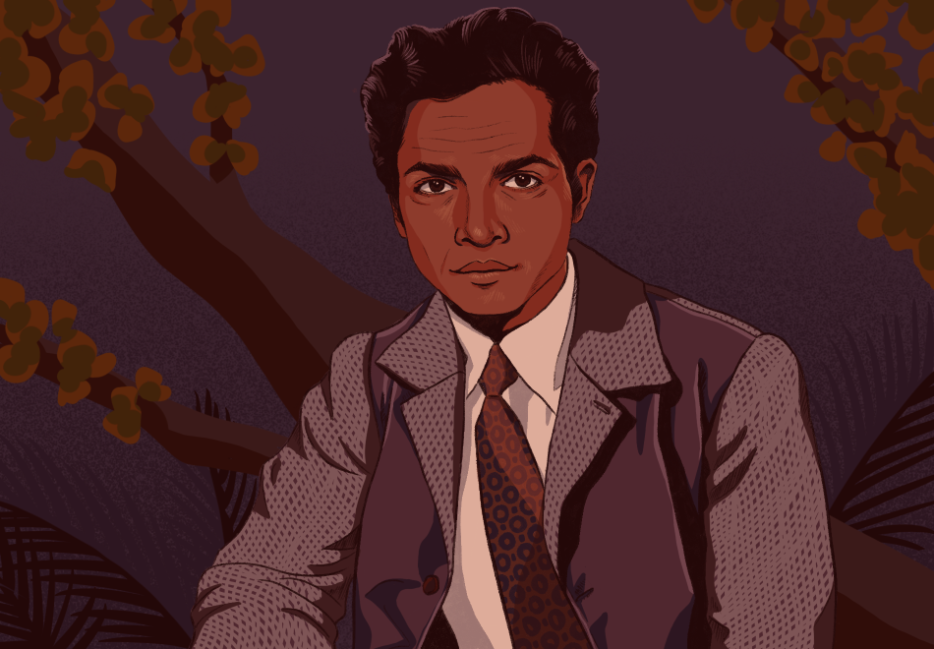Welcome to the second instalment in “Brown Hollywood,” a three-part series of essays by Mayukh Sen exploring undertold stories of South Asian performers in Hollywood’s Golden Age.
He moves with grace. Mowgli, a boy raised by a pack of wolves in the scrap of the Indian jungle, can barely speak when he first appears in Jungle Book (1942). The character communicates, mostly, in growls, howls, and barks; he cocks his head in confusion upon hearing human speech. Despite this, this little boy playing Mowgli—with his soft gaze and nimble limbs—provides a jolt of energy to this colonial fantasia, one whose Technicolor palette heightens the artifice on display. Surrounding him is a raft of white actors, their skin caramelized through makeup; they speak as if they’ve come straight from New England. But this performer is different from them all, radiant in his truth, finding poetry in what his audience may have considered primitive.
Jungle Book was the first Hollywood film that Sabu Selar Shaikh, better known by his screen mononym Sabu, starred in; he was all of eighteen upon the film’s release. Beginning with his British cinema debut in Elephant Boy in 1937, Sabu had become an improbable star of Anglo-American cinema, though his popularity would last only a few years longer. His fame was a miracle in a period of abiding bigotry toward South Asians in Hollywood, and America more generally. The Immigration Act of 1917 outlawed South Asian immigration from what was then British India, while a 1923 Supreme Court ruling also curtailed the possibility of their gaining citizenship. On the Hollywood front, filmmakers had to obey the puritanical mandates of the Hays Code, its instructions against depicting interracial romance curtailing meatier opportunities for performers of colour.
As a consequence, this was a time when South Asian performers had few chances to make their mark in American film. But Sabu was able to buck these conventions through, in no small part, the sheer voltage of his charisma. During the last gasp of Britain’s strangle over South Asia, he put forth a vibrant image of his home soil that captured American moviegoers’ hearts, a spell that would dissolve as the culture skidded past him.
*
“I salute you, sahibs,” he announces in his first scene in Elephant Boy, based on a story by Rudyard Kipling, staring into the eye of the camera. “How do you do? Men call me Toomai of the Elephants.” He seems to speak directly to the viewer, his eyes only occasionally darting off to the side, as if he is reading cue cards. In truth, Sabu, whose mother tongue was Kannada, was reciting his lines phonetically. “I learned the words, but I didn’t know what they meant,” he would later tell the columnist Louella Parsons of that film. “Each day I spoke English the way they told me how to say each sentence. It was very funny, so different from my native tongue.”
In that film, Toomai, the son of a mahout—or elephant rider—cavorts through the foliage of the Indian jungle with his trusted, though sometimes unwieldy, elephant, Kala Nag. The film tasks Sabu with heavy dramatic material that he handles with unaffected ease; his father dies during a tiger hunt, leaving his orphaned son to navigate his grief. Sabu’s naturalism is so moving that he gives the film its pulse. What he may have lacked in polish or technique Sabu more than compensated with his innate star presence. It is clear, watching this film today, why the incandescence on display carried him far beyond this one-off project.
The role bore neat parallels to Sabu’s off-screen biography. Born in 1924 just outside the city of Mysore (which is today in the South Indian state of Karnataka), Sabu was orphaned young. Accounts of Sabu’s early years suggest his father had been a mahout himself. One day in the spring of 1935, the boy came to the stables of the Maharajah of Mysore, a place teeming with elephants, begging for food. It was there that the crew assisting the Hungarian-born British film magnate Alexander Korda, head of the leading production company London Films, stumbled upon Sabu. They had been prospecting for “a little Hindu boy who has not become sophisticated,” as one of Elephant Boy’s two co-directors, Robert Flaherty (the other was Korda’s brother Zoltán), would later say. (“Hindu,” in the Western parlance of the era, was a byword for anyone of South Asian descent regardless of religious belief; Sabu was, in actuality, Muslim, a matter in which he took great pride.) Flaherty thought the boy had “a smile like a sunrise”; the film’s cinematographer, Osmond Borradaile, was struck by Sabu’s “alert eyes, ready smile, strong body, and forthright manner.” They had found their Toomai.
Sabu was twelve when London Films flew him to England. Upon arriving in the belly of the empire, Sabu found that whatever fascination he engendered within British moviegoers came with a heavy tinge of racism; one reviewer called him “a brown frog of a boy.” But most critics were smitten, for this was a period in which Britain’s grip over India was becoming more tenuous. Sabu’s presence on British screens would have been a panacea for any insecurities about the vitality of the British Empire: He was the promise of colonialism made flesh, a grimy boy salvaged from the grunge of India and “civilized” by his white handlers. The studio generated fawning press for itself by putting Sabu through school. He learned how to use cutlery, started to wear British suits, and even posed in photo shoots that featured him washing his face clean with soap, literalizing this symbolic trajectory.
Sabu would spend the next few years as a contract player with London Films, repeatedly pushed into other projects like The Drum (1938), a Technicolor extravaganza in which he played an Indian prince named Azim who allies himself with his British overlords to capsize his evil uncle (who has killed Azim’s father). That film would expose Sabu, just fourteen upon the film’s release, to criticism from audiences in his birth country, who chided him for peddling a regressive spectacle of their homeland that was out of lockstep with reality. During that time, long-gestating resistance to British rule within South Asia was coalescing into an independence movement. The era’s leading film magazine, Filmindia, lambasted Sabu’s stardom as that of “the popularity of a faithful dog or horse.” There were even reports of protests erupting in theatres across British India where the film played. Yet watching that troubling film today, one sees Sabu doing his best within the oppression of his aesthetic circumstances, refusing to be cratered by the stereotypes of earnest loyalty that this film imposed upon him; even when he seems to be operating in bright-eyed subservience to British rule, his magnetism transfixes.
The entry of Britain into World War II led Korda to transplant his business operations to Los Angeles, bringing Sabu along with him. By the time Sabu arrived in America, it had been over a decade since the British-born Anglo-Indian actor Boris Karloff had risen to fame through his horror work, all while suppressing his South Asian heritage and masquerading as Russian. The only other prominent South Asian Hollywood star of that era was Merle Oberon, born into the Anglo-Indian community of what was then called Bombay. Another Korda charge (and later his wife), Oberon found herself forced by studio suits to conceal her maternal South Asian lineage and pass for white in order to have a career. When Oberon arrived in Hollywood in late 1934, reporters assailed her with questions about her mother being a “Hindu,” and she had little choice but to parry those efforts to expose her by sticking to the line that London Films fed her, pretending that she had been born to white parents on the Australian island of Tasmania.
Once Sabu came to Hollywood in the early 1940s, though, conditions had already changed for South Asians, making the time more suitable for his success. A spate of sweeping dramas set in British India, like Gunga Din (1939) and The Rains Came (1939), set the box office alight, albeit with an absence of South Asian performers in principal roles, instead relying on white actors in brownface. Sabu would thus have appealed to moviegoers eager for a flavour of truth, while his youth would dampen any threat that his brown skin portended. The press sometimes positioned him as the antipode to Shirley Temple, the pudding-cheeked adolescent whose twinkling smile opened her up to critiques that her precociousness was a put-on, that she was merely a studio-manufactured product. Sabu, in contrast, was possessed of a resolutely earthbound quality, along with the heady perfume of the unfamiliar to American audiences.
Consider, too, that despite the endurance of previous immigration laws that hamstrung entry of South Asians into America (a restriction Sabu was able to bypass because of his affiliation with Korda), aspects of the region’s culture came into sudden vogue during that period. “Turbans do things for you!” shouted an advertisement for the department store Sears in 1940, reflecting the popularity of turbans amongst middle- and upper-middle-class white women in America. When parading himself in public, Sabu often swaddled his head in cherry-red turbans, a costume that became part of his public image. “I like red,” he told a reporter when asked about the colour of his turban, with unpractised and shimmering innocence. His Hollywood debut, Jungle Book, was thus an apt launch pad for Sabu, the story of a boy trying to prove his worth and assimilate at a time when America had halted legal immigration of Sabu’s countryfolk.
Assimilate is precisely what Sabu did in the intervening years as he grew fonder of America. After Jungle Book, Sabu tired of his London Films contract, and he loosened himself from the Korda clutch by staying in Hollywood and signing with Universal Pictures. That yearning for artistic freedom may have ultimately cost him lasting fame. The studio cycled him through a series of parts that seemed like a greatest hits compilation, riffing on his previous roles without the Korda finesse. He did his best to retain his dignity despite narrative marginalization—he was often the sidekick in these films—and only one of those films, 1942’s Arabian Nights (in which he played an acrobat), was a box office success. As Sabu grew older, his lithe body became a canvas for projection of a fantasy of brown virility, tangling the “exotic”—a word frequently glued to him by the media—with the erotic, and the films he was in emphasized his statuesque musculature.
With America’s entry into World War II came the exodus of a number of the industry’s leading men into combat, and Sabu dutifully followed suit, expressing fealty to a country that embraced him. He enlisted in the United States Air Force, completing over forty missions in the South Pacific. “How does an Indian boy and film star react to the Army?” one reporter asked him. “Like everyone else,” he responded, smiling. “It was very strange at first. But you learn fast.” His service allowed him to skirt the repressive laws of the time, granting him American citizenship just before his twentieth birthday in 1944, a privilege that was not generally afforded to other South Asian immigrants at the time.
Sabu gained his citizenship just prior to two significant geopolitical and cultural shifts that directly impacted the stature of South Asians in both his home and adopted countries, as the film scholar Michael Lawrence points out in his 2014 monograph, Sabu. (It is one of the few books dedicated to Sabu, the two others being a 2010 biography by Philip Leibfried, Star of India, and a 2021 biography, SABU, by Debleena Majumdar put out in India.) First, following World War II’s end, the passing of America’s Luce–Celler Act in 1946 eased the difficulty of South Asian immigration by establishing quotas for entry of immigrants from the British Raj (along with the Philippines, which was itself on the cusp of independence from the United States). It also allowed them to gain American citizenship. Second, a year later in South Asia, the British lost control over their colony, resulting in Indian independence and a violent partition that ensued from the hasty slicing of the land into Pakistan—which then included present-day Bangladesh—and India. These events coincided with the downturn of Sabu’s film acting career. As a consequence of those changes far bigger than him, Sabu found that the adventurous travelogues that had ferried him to celebrity fell out of fashion. His stardom was over.
*
In 1953, for the first time since his childhood, Sabu returned to India. “I come with a strange feeling in my heart,” he told reporters, flanked by his wife, the white American actress Marilyn Cooper, and their son Paul. “It is nice to return to your own country.” But that nation was unwilling to accept him. He remained an object of censure for the Indian press for serving as a participant in a culture of debasement against South Asians. Because his film career had taken a backslide, some onlookers suspected that he had only come to India seeking financial opportunity. It was true that he had come to make a film there, Sauda, that went uncompleted. This man who had given himself to his adopted country, only to be discarded by it due to the fickle tastes of moviegoers, now found himself rejected by the nation where he’d been born.
Sabu had spent the post-Independence years in a state of professional itinerance, dabbling in real estate and even, at one point, joining the Harringay Circus in England, handling pachyderms like he had in his film debut. He also found himself ensconced in scandals, which included a paternity suit from a woman who alleged he fathered a child with her during an affair (he maintained that the child was not his while agreeing to pay support). While tending to these commotions, Sabu was grinding through thankless film roles and stints on television, strenuously trying to recoup the glory of his past. Some of these titles tried to capitalize on whatever appeal his name had once held to American moviegoers; in the 1957 film Sabu and the Magic Ring, he starred as himself.
When Sabu died of a heart attack in December 1963, just before he hit forty, he may have seemed like a trinket from a bygone cinematic era, or, to those in the country from which money-hungry filmmakers whisked him away, a patsy for a failed colonial project. Look closer, however, and one might find a boy who had to grow up very fast and very publicly, who did his best to retain his self-worth in a series of milieus determined to exploit him. If some of Sabu’s more famous films cast him as little more than a prop, he attempted to be so much more, demonstrating his humanity in a climate eager to diminish South Asians. One sees this struggle, and eventual triumph, in the closing moments of Jungle Book. There, Sabu delivers a monologue that could double as a statement on the nature of his career’s great endeavour to provide a positive portrait of his people. “Their trail is my trail,” his Mowgli says before he retreats to the jungle where he is most comfortable, firm in his insistence that whatever choices he made as an individual served a greater good. “Their fight is my fight.”






